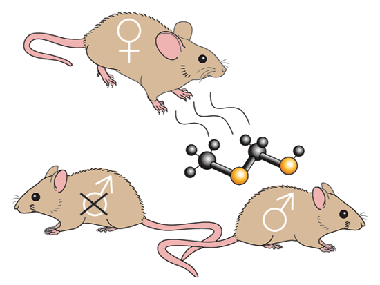Chemist Eric Block Explores Links Between Copper and Sense of Smell
 |
|
Research by Duke University and UAlbany has shown that copper ions allow the female mouse to detect sulfur-containing chemicals in the urine of a male mouse suitor. (Graphic by Ann Thomson)
|
ALBANY, N.Y. (February 6, 2012) -- Researchers at Duke University Medical Center and the University at Albany have found the secret to what makes most mammals recoil from sulfur chemical smells, while letting the female mouse know there’s a male seeking amour – the copper in mammalian bodies.
Senior author Hiroaki Matsunami, Ph.D., associate professor of molecular genetics and microbiology and of neurobiology at Duke University, set out to study a sulfur-containing chemical in male mouse urine called MTMT that attracts female mice. He did not realize, however, that he would stumble into a new field of study – one that would advance knowledge into the least understood of all of our senses, the sense of smell.
Working with UAlbany chemist Eric Block, Ph.D., Carla Rizzo Delray Distinguished Professor of Chemistry, the team looked at reasons why mammals, including people, can detect even trace amounts of sulfur-containing substances, like MTMT.
The work is published in this week’s PNAS Online, the website of the Proceedings of the National Academy of Sciences of the United States of America.
In a 2005 study, the late Duke neuroscientist Lawrence C. Katz, working with Block, found the first evidence of neurons responsive to social odors, using a new analytical approach to isolate one of these social odors – MTMT, a sulfur-containing chemical in urine that enables mice to distinguish between the sexes – defining maleness in the mice.
“One of the important questions remaining to be answered at that time was how a volatile small molecule such as MTMT gets recognized by the receptor proteins found in the olfactory bulb,” said Block. He recommended to the Duke laboratory that it undertake a “sustained team effort” to identify the particular receptors in the mouse that recognized MTMT from the vast universe of smells with which it comes in contact.
At Duke, Matsunami and fellow neurobiologist Hanyi Zhuang ran a high-throughput test of several hundred mammalian odor receptors, and found that one receptor resulted in superior detection of even trace amounts of MTMT when copper ions were present.
“We learned that copper definitely was involved in the ability to smell sulfur compounds, and it was Eric Block’s idea that metal ions must be involved,” said Matsunami. “Further, I see no reason why the mouse receptor activity would be different from human receptors, because we have the same kind of olfactory receptors.”
Block and colleagues at UAlbany created several dozen sulfur-containing compounds for testing, and copper was the metal that allowed for detection through the receptor. The Duke team also did experiments using a chemical that binds to copper in the mouse nose, so that copper wasn’t available to the receptors, and the mice didn’t detect the MTMT, Matsunami said.
“This study establishes for the first time the key role of a metal, namely copper, in the activity of an olfactory receptor,” said Block. “What’s also exciting is that, because olfactory receptors are transmembrane G protein-coupled receptors of the same type as receptors for drugs, our discovery suggests a possibility that some drug receptor responses may also be enhanced in the presence of copper or other metal ions.”
Postdoctoral fellows Siji Thomas and Shaozhong Zhang of UAlbany’s Department of Chemistry also participated in the research, supported by the National Science Foundation.
Block, the 2012 winner of the U.S. Department of Agriculture’s Sterling B. Hendricks Memorial Lectureship Award, will discuss these latest research results at the American Chemical Society meeting in Philadelphia this August.
![]() For more news, subscribe to UAlbany's RSS headline feeds
For more news, subscribe to UAlbany's RSS headline feeds
A comprehensive public research university, the University at Albany-SUNY offers more than 120 undergraduate majors and minors and 125 master's, doctoral and graduate certificate programs. UAlbany is a leader among all New York State colleges and universities in such diverse fields as atmospheric and environmental sciences, business, education, public health,health sciences, criminal justice, emergency preparedness, engineering and applied sciences, informatics, public administration, social welfare and sociology, taught by an extensive roster of faculty experts. It also offers expanded academic and research opportunities for students through an affiliation with Albany Law School. With a curriculum enhanced by 600 study-abroad opportunities, UAlbany launches great careers.


